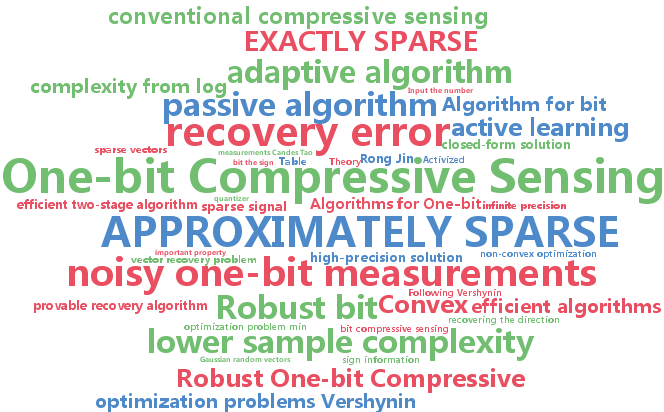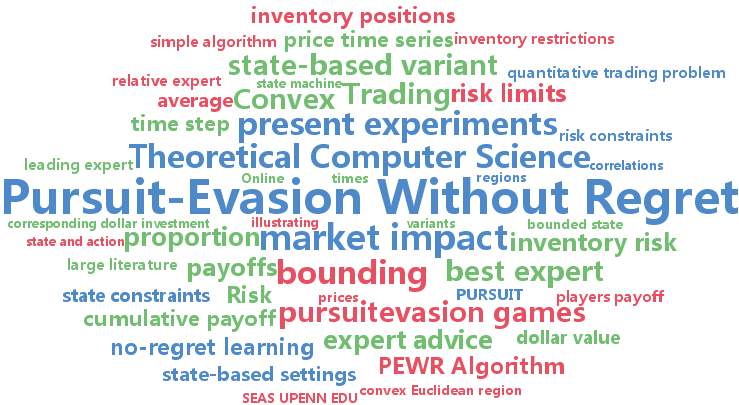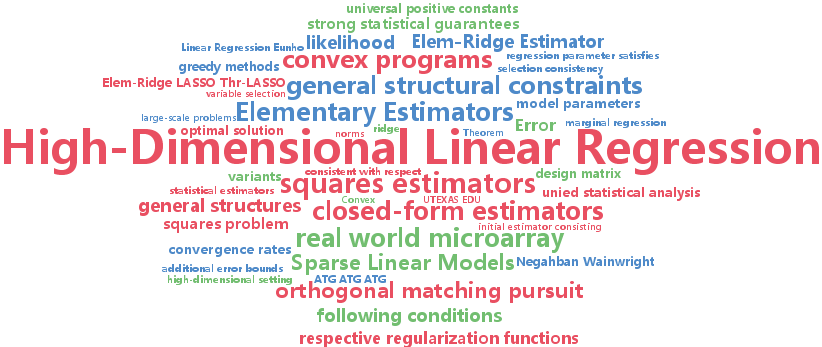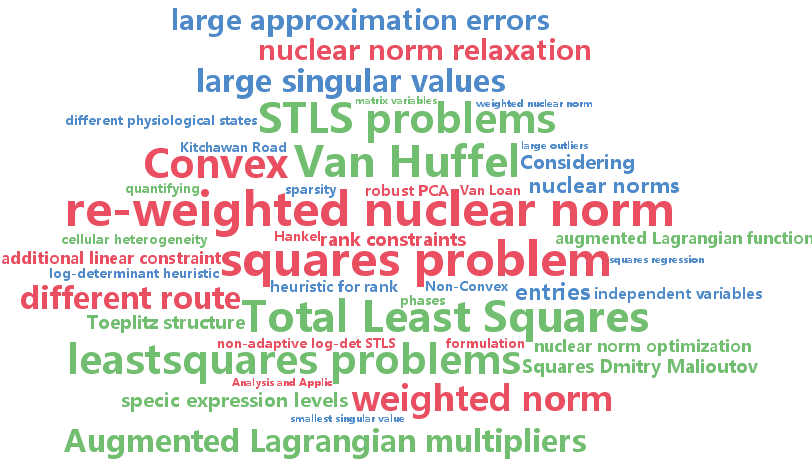convex
-
Lijun Zhang and Jinfeng Yi and Rong Jin
Efficient Algorithms for Robust One-bit Compressive Sensing (pdf)
While the conventional compressive sensing assumes measurements of infinite precision, one-bit compressive sensing considers an extreme setting where each measurement is quantized to just a single bit. In this paper, we study the vector recovery problem from noisy one-bit measurements, and develop two novel algorithms with formal theoretical guarantees. First, we propose a passive algorithm, which is very efficient in the sense it only needs to solve a convex optimization problem that has a closed-form solution. Despite the apparent simplicity, our theoretical analysis reveals that the proposed algorithm can recover both the exactly sparse and the approximately sparse vectors. In particular, for a sparse vector with $s$ nonzero elements, the sample complexity is $O(s \log n/\epsilon^2)$, where $n$ is the dimensionality and $\epsilon$ is the recovery error. This result improves significantly over the previously best known sample complexity in the noisy setting, which is $O(s \log n/\epsilon^4)$. Second, in the case that the noise model is known, we develop an adaptive algorithm based on the principle of active learning. The key idea is to solicit the sign information only when it cannot be inferred from the current estimator. Compared with the passive algorithm, the adaptive one has a lower sample complexity if a high-precision solution is desired.
-
Zheng Wang and Ming-Jun Lai and Zhaosong Lu and Wei Fan and Hasan Davulcu and Jieping Ye
Rank-One Matrix Pursuit for Matrix Completion (pdf)
Low rank matrix completion has been applied successfully in a wide range of machine learning applications, such as collaborative filtering, image inpainting and Microarray data imputation. However, many existing algorithms are not scalable to large-scale problems, as they involve computing singular value decomposition. In this paper, we present an efficient and scalable algorithm for matrix completion. The key idea is to extend the well-known orthogonal matching pursuit from the vector case to the matrix case. In each iteration, we pursue a rank-one matrix basis generated by the top singular vector pair of the current approximation residual and update the weights for all rank-one matrices obtained up to the current iteration. We further propose a novel weight updating rule to reduce the time and storage complexity, making the proposed algorithm scalable to large matrices. We establish the linear convergence of the proposed algorithm. The fast convergence is achieved due to the proposed construction of matrix bases and the estimation of the weights. We empirically evaluate the proposed algorithm on many real-world large scale datasets. Results show that our algorithm is much more efficient than state-of-the-art matrix completion algorithms while achieving similar or better prediction performance.
-
Lili Dworkin and Michael Kearns and Yuriy Nevmyvaka
Pursuit-Evasion Without Regret, with an Application to Trading (pdf)
We propose a state-based variant of the classical online learning problem of tracking the best expert. In our setting, the actions of the algorithm and experts correspond to local moves through a continuous and bounded state space. At each step, Nature chooses payoffs as a function of each player's current position and action. Our model therefore integrates the problem of prediction with expert advice with the stateful formalisms of reinforcement learning. Traditional no-regret learning approaches no longer apply, but we propose a simple algorithm that provably achieves no-regret when the state space is any convex Euclidean region. Our algorithm combines techniques from online learning with results from the literature on pursuit-evasion games. We describe a quantitative trading application in which the convex region captures inventory risk constraints, and local moves limit market impact. Using historical market data, we show experimentally that our algorithm has a strong advantage over classic no-regret approaches.
-
Rémi Lajugie and Francis Bach and Sylvain Arlot
Large-Margin Metric Learning for Constrained Partitioning Problems (pdf)
We consider unsupervised partitioning problems based explicitly or implicitly on the minimization of Euclidean distortions, such as clustering, image or video segmentation, and other change-point detection problems. We emphasize on cases with specific structure, which include many practical situations ranging from mean-based change-point detection to image segmentation problems. We aim at learning a Mahalanobis metric for these unsupervised problems, leading to feature weighting and/or selection. This is done in a supervised way by assuming the availability of several (partially) labeled datasets that share the same metric. We cast the metric learning problem as a large-margin structured prediction problem, with proper definition of regularizers and losses, leading to a convex optimization problem which can be solved efficiently. Our experiments show how learning the metric can significantly improve performance on bioinformatics, video or image segmentation problems.
-
Eunho Yang and Aurelie Lozano and Pradeep Ravikumar
Elementary Estimators for High-Dimensional Linear Regression (pdf)
We consider the problem of structurally constrained high-dimensional linear regression. This has attracted considerable attention over the last decade, with state of the art statistical estimators based on solving regularized convex programs. While these typically non-smooth convex programs can be solved in polynomial time, scaling the state of the art optimization methods to very large-scale problems is an ongoing and rich area of research. In this paper, we attempt to address this scaling issue at the source, by asking whether one can build \emph{simpler
-
Dmitry Malioutov and Nikolai Slavov
Convex Total Least Squares (pdf)
We study the total least squares (TLS) problem that generalizes least squares regression by allowing measurement errors in both dependent and independent variables. TLS is widely used in applied fields including computer vision, system identifi cation and econometrics. The special case when all dependent and independent variables have the same level of uncorrelated Gaussian noise, known as ordinary TLS, can be solved by singular value decomposition (SVD). However, SVD cannot solve many important practical TLS problems with realistic noise structure, such as having varying measurement noise, known structure on the errors, or large outliers requiring robust error-norms. To solve such problems, we develop convex relaxation approaches for a general class of structured TLS (STLS). We show both theoretically and experimentally, that while the plain nuclear norm relaxation incurs large approximation errors for STLS, the re-weighted nuclear norm approach is very effective, and achieves better accuracy on challenging STLS problems than popular non-convex solvers. We describe a fast solution based on augmented Lagrangian formulation, and apply our approach to an important class of biological problems that use population average measurements to infer cell-type and physiological-state specific expression levels that are very hard to measure directly.





